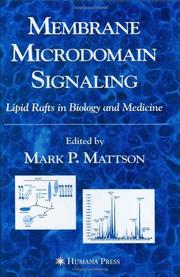| Listing 1 - 10 of 11 | << page >> |
Sort by
|
Book
Year: 2005 Publisher: [Place of publication not identified] Elsevier Academic Press
Abstract | Keywords | Export | Availability | Bookmark
 Loading...
Loading...Choose an application
- Reference Manager
- EndNote
- RefWorks (Direct export to RefWorks)
Acid Anhydride Hydrolases --- Cell Physiological Processes --- Cellular Structures --- Cells --- Hydrolases --- Cell Physiological Phenomena --- Enzymes --- Anatomy --- Enzymes and Coenzymes --- GTP Phosphohydrolases --- Membrane Fusion --- Cell Membrane

ISBN: 1416023283 9781416023289 Year: 2005 Publisher: Philadelphia Elsevier Saunders
Abstract | Keywords | Export | Availability | Bookmark
 Loading...
Loading...Choose an application
- Reference Manager
- EndNote
- RefWorks (Direct export to RefWorks)
Human physiology --- Physiology --- Cell Physiological Phenomena --- Physiology. --- Cell Physiological Phenomena. --- 612 --- Cell Physiological Phenomenon --- Physiology, Cell --- Cell Physiology --- Phenomena, Cell Physiological --- Phenomenon, Cell Physiological --- Cells --- Fysiologie --- physiology --- Cell Physiological Process --- Cell Physiological Processes --- Physiological Process, Cell --- Physiological Processes, Cell --- Process, Cell Physiological --- Processes, Cell Physiological --- Human biology --- Medical sciences --- Human body
Book
Year: 2005 Volume: v. 71 Publisher: Amsterdam ; Boston : Elsevier,
Abstract | Keywords | Export | Availability | Bookmark
 Loading...
Loading...Choose an application
- Reference Manager
- EndNote
- RefWorks (Direct export to RefWorks)
Muscle Proteins. --- Muscle contraction --- Proteins. --- Muscle proteins. --- Tubulins. --- Microtubules. --- Muscle Contraction. --- Molecular Motor Proteins. --- Musculoskeletal Physiological Processes --- Locomotion --- Cell Physiological Processes --- Multiprotein Complexes --- Adenosine Triphosphatases --- Macromolecular Substances --- Acid Anhydride Hydrolases --- Musculoskeletal Physiological Phenomena --- Cell Physiological Phenomena --- Movement --- Hydrolases --- Physiological Processes --- Musculoskeletal and Neural Physiological Phenomena --- Chemicals and Drugs --- Phenomena and Processes --- Enzymes --- Physiological Phenomena --- Enzymes and Coenzymes --- Molecular Motor Proteins --- Muscle Contraction --- Cell Movement --- Regulations.
Periodical
ISSN: 18601499 18601480 Year: 2005 Publisher: Tokyo [Japan] : Springer,
Abstract | Keywords | Export | Availability | Bookmark
 Loading...
Loading...Choose an application
- Reference Manager
- EndNote
- RefWorks (Direct export to RefWorks)
Molecular biology --- Cell physiology --- Electron microscopy --- Cell physiology. --- Electron microscopy. --- Molecular biology. --- Microscopie électronique. --- Microscopie. --- Maladie. --- Aspect moléculaire. --- Microscopy, Electron. --- Electron Microscopy --- Molecular biochemistry --- Molecular biophysics --- Cell function --- Biochemistry --- Biophysics --- Biomolecules --- Systems biology --- Microscopy --- Cytology --- Physiology --- Molecular Biology --- Cell Physiology --- Microscopy, Electron --- Cell Physiological Phenomenon --- Cell Physiological Process --- Physiology, Cell --- Cell Physiological Processes --- Phenomena, Cell Physiological --- Phenomenon, Cell Physiological --- Physiological Process, Cell --- Physiological Processes, Cell --- Process, Cell Physiological --- Processes, Cell Physiological --- Cells --- Biochemical Genetics --- Biology, Molecular --- Genetics, Biochemical --- Genetics, Molecular --- Molecular Genetics --- Biochemical Genetic --- Genetic, Biochemical --- Genetic, Molecular --- Molecular Genetic --- Genetic Phenomena --- physiology --- Molecular Biology. --- Cell Physiological Phenomena.

ISBN: 9780444529275 0444529276 9780444512338 0444512330 Year: 2005 Publisher: [Place of publication not identified] Elsevier
Abstract | Keywords | Export | Availability | Bookmark
 Loading...
Loading...Choose an application
- Reference Manager
- EndNote
- RefWorks (Direct export to RefWorks)
A volume in the Handbook of Clinical Neurophysiology series on the visual system. The ultimate reference source for clinical neurophysiologists on disorders of visual processing. Volume in a prestigious series published in association with the International Federation of clinical Neurophysiology. International contributor list drawn from around the world. Discusses anatomy and physiology, techniques used in clinical neurophysiology, disorders of peripheral visual processing and disorders of central visual processing.
Eye Diseases --- Diagnostic Techniques and Procedures --- Light Signal Transduction --- Afferent Pathways --- Sensation Disorders --- Sensation --- Neurobehavioral Manifestations --- Ocular Physiological Processes --- Signal Transduction --- Diagnosis --- Neurologic Manifestations --- Behavior and Behavior Mechanisms --- Ocular Physiological Phenomena --- Psychophysiology --- Neural Pathways --- Nervous System Physiological Processes --- Diseases --- Biochemical Processes --- Nervous System --- Analytical, Diagnostic and Therapeutic Techniques and Equipment --- Signs and Symptoms --- Phenomena and Processes --- Psychological Phenomena and Processes --- Nervous System Diseases --- Psychiatry and Psychology --- Cell Physiological Processes --- Nervous System Physiological Phenomena --- Cell Physiological Phenomena --- Chemical Processes --- Pathological Conditions, Signs and Symptoms --- Musculoskeletal and Neural Physiological Phenomena --- Anatomy --- Biochemical Phenomena --- Chemical Phenomena --- Perceptual Disorders --- Vision, Ocular --- Visual Pathways --- Diagnostic Techniques, Ophthalmological --- Vision Disorders --- Diagnostic Techniques, Neurological

ISBN: 9781588293541 1588293548 9781592598038 9786610358243 1280358246 159259803X Year: 2005 Publisher: Totowa, N.J. : Humana Press,
Abstract | Keywords | Export | Availability | Bookmark
 Loading...
Loading...Choose an application
- Reference Manager
- EndNote
- RefWorks (Direct export to RefWorks)
Lipid rafts-discrete regions in cell membranes that are rich in cholesterol and sphingolipids-are emerging not only as pivotal command and control centers for cellular signaling processes, but also as central to a wide array of human diseases, including immune disorders, diabetes, cardiovascular disease, and Alzheimer's disease. In Membrane Microdomain Signaling: Lipid Rafts in Biology and Medicine, multidisciplinary experts offer cutting-edge reviews of our current understanding of these membrane microdomains and their physiological and pathological roles. Here, readers will discover how lipid rafts change in cells over time and how they respond to various environmental signals, how cholesterol modulates the signaling function of lipid rafts, and how lipid rafts, the extracellular matrix, and the cell cytoskeleton structurally interact. Also described are the role of lipid rafts in learning, memory, and cancer, and as portals for endocytic uptake of an anticancer- and apoptotic alkyl-lysophospholipid. The authors also present emerging evidence that lipid rafts play critical roles in signaling pathways and the regulation of synaptic function in the nervous system, and that alterations in lipid raft metabolism are implicated in the pathogenesis of neurodegenerative disorders. They also describe techniques for the isolation of lipid rafts, the analysis of the lipid and protein components of lipid rafts, the imaging of lipid rafts in living cells, and the analysis of signal transduction in lipid rafts. Comprehensive and insightful, Membrane Microdomain Signaling: Lipid Rafts in Biology and Medicine offers researchers a multidisciplinary review of the latest basic, translational, and clinical research that promises to transform our understanding microdomain signaling mechanisms.
Membrane Microdomains --- Apoptosis --- Lipids --- Signal Transduction --- Synapses --- Membrane lipids --- Cellular signal transduction --- Lipides membranaires --- Transduction du signal cellulaire --- pathology --- physiology --- metabolism --- Apoptosis. --- Cellular signal transduction. --- Membrane lipids. --- Metabolism --- Physiology --- Lipid Metabolism --- Pathology --- Biochemical Processes --- Nervous System --- Cell Membrane Structures --- Metabolic Phenomena --- Chemicals and Drugs --- Cell Death --- Cell Physiological Processes --- Medicine --- Intercellular Junctions --- Biological Science Disciplines --- Phenomena and Processes --- Natural Science Disciplines --- Biochemical Phenomena --- Cell Membrane --- Cell Physiological Phenomena --- Chemical Processes --- Health Occupations --- Anatomy --- Cellular Structures --- Disciplines and Occupations --- Chemical Phenomena --- Cells --- Cytology --- Animal Biochemistry --- Human Anatomy & Physiology --- Biology --- Health & Biological Sciences --- Cellular information transduction --- Information transduction, Cellular --- Signal transduction, Cellular --- Life sciences. --- Cell biology. --- Life Sciences. --- Cell Biology. --- Bioenergetics --- Cellular control mechanisms --- Information theory in biology --- Membranes (Biology)

ISSN: 15431894 ISBN: 9781588292964 1588292967 9781592598267 1592598269 1280831782 9786610831784 Year: 2005 Volume: 105 Publisher: Totowa, NJ : Humana Press : Imprint: Humana,
Abstract | Keywords | Export | Availability | Bookmark
 Loading...
Loading...Choose an application
- Reference Manager
- EndNote
- RefWorks (Direct export to RefWorks)
Over the past decade technical and conceptual breakthroughs, cross-species comparisons, and multidisciplinary approaches have led to a virtual revolution in developmental biology. In Developmental Hematopoiesis: Methods and Protocols, a panel of expert investigators critically surveys an array of methods available to study hematopoiesis and describes in detail the powerful techniques they have established to investigate embryonic, fetal, and (to a lesser extent) postnatal blood development. The authors apply their approaches to invertebrate (fruit flies) as well as vertebrate (frog, fish, mouse, chick, and human) organisms. These state-of-the-art techniques range from the genetic, molecular, and cellular, to cell and embryo explant culture and whole animals, including in vivo imaging. Bioinformatic and functional genomic approaches for studying stem cells and their supportive stromal cells are also discussed. The protocols follow the successful Methods in Molecular Medicine™ series format, each one offering step-by-step laboratory instructions, an introduction outlining the principle behind the technique, lists of the necessary equipment and reagents, and tips on troubleshooting and avoiding known pitfalls. Cutting-edge and highly practical, Developmental Hematopoiesis: Methods and Protocols offers novice and seasoned researchers alike the critical tools needed to gain a fundamental understanding of stem cell biology-examining not only how hematopoietic stem cells form, but also how they differ in the embryo, the fetus, and the adult.
Hematopoiesis --- Embryo Research --- Hematopoietic Stem Cells --- Models, Animal --- Molecular Biology --- Hematopoietic system --- Developmental biology --- Biologie du développement --- genetics --- cytology --- methods --- Growth --- Laboratory manuals --- Manuels de laboratoire --- Embryo Research. --- Models, Animal. --- genetics. --- cytology. --- methods. --- Developmental biology -- Laboratory manuals. --- Hematopoietic system -- Growth -- Laboratory manuals. --- Bone Marrow Cells --- Investigative Techniques --- Blood Physiological Processes --- Cell Differentiation --- Stem Cells --- Biomedical Research --- Biology --- Biochemistry --- Chemistry --- Analytical, Diagnostic and Therapeutic Techniques and Equipment --- Biological Science Disciplines --- Cells --- Cell Physiological Processes --- Hematopoietic System --- Research --- Blood Physiological Phenomena --- Natural Science Disciplines --- Circulatory and Respiratory Physiological Phenomena --- Cell Physiological Phenomena --- Hemic and Immune Systems --- Anatomy --- Science --- Disciplines and Occupations --- Phenomena and Processes --- Methods --- Genetics --- Human Anatomy & Physiology --- Health & Biological Sciences --- Physiology --- Development (Biology) --- Hemopoietic system --- Ontogeny --- Hematology. --- Haematology --- Internal medicine --- Blood --- Diseases --- Hematopoietic system - Growth - Laboratory manuals. --- Developmental biology - Laboratory manuals. --- Hematopoiesis - genetics. --- Hematopoietic Stem Cells - cytology. --- Molecular Biology - methods.

ISBN: 9781588291721 1588291723 9781592598519 9786610358199 128035819X 159259851X Year: 2005 Publisher: Totowa, N.J. : Humana Press,
Abstract | Keywords | Export | Availability | Bookmark
 Loading...
Loading...Choose an application
- Reference Manager
- EndNote
- RefWorks (Direct export to RefWorks)
Cell death, or apoptosis, plays an important role in biological processes and disease and offers special opportunities to develop new therapies for cancer, autoimmune disease, stroke, heart attack, and Alzheimer's disease. In Death Receptors in Cancer Therapy, leading physician-scientists and basic researchers review in depth our latest understanding of the molecular events that regulate cell death, illuminating those molecules that provide targets for agonists or antagonists designed to modulate death signaling for therapeutic purposes. The authors focus on the extrinsic system of death receptors, their regulation and function, and their abnormalities in cancer. Topics of particlar interest include resistance to apoptosis, TRAIL signaling, death receptors in embryonic development, mechanisms of caspase activation, and death receptor mutations in cancer. Additional chapters address death signaling in melanoma, synthetic retinoids and death receptors, the role of p53 in death receptor regulation, immune suppression of cancer, and combination therapy with death ligands. Authoritative and up-to-date, Death Receptors in Cancer Therapy offers a timely compendium of cell death signaling pathways for those seeking either a basic understanding of apoptosis or the knowledge needed to develop new therapeutics that will activate or block death signaling in disease.
Neoplasms --- Cell Death --- Gene Therapy --- Receptors, Tumor Necrosis Factor --- Apoptosis --- Cell receptors --- Cancer --- Cellular signal transduction --- Apoptose --- Récepteurs cellulaires --- Transduction du signal cellulaire --- immunology --- therapy --- methods --- Molecular aspects --- Aspect moléculaire --- Kanker --- Kanker ; moleculaire aspecten --- Apoptosis. --- Cancer -- Molecular aspects. --- Cell receptors. --- Cellular signal transduction. --- Biological Therapy --- Genetic Engineering --- Diseases --- Investigative Techniques --- Cell Physiological Processes --- Receptors, Cytokine --- Cell Physiological Phenomena --- Receptors, Immunologic --- Analytical, Diagnostic and Therapeutic Techniques and Equipment --- Genetic Techniques --- Therapeutics --- Receptors, Cell Surface --- Phenomena and Processes --- Membrane Proteins --- Proteins --- Amino Acids, Peptides, and Proteins --- Chemicals and Drugs --- Methods --- Medicine --- Biology --- Health & Biological Sciences --- Cytology --- Oncology --- Molecular aspects. --- Cellular information transduction --- Information transduction, Cellular --- Signal transduction, Cellular --- Cell membrane receptors --- Cell surface receptors --- Receptors, Cell --- Medicine. --- Oncology. --- Medicine & Public Health. --- Tumors --- Clinical sciences --- Medical profession --- Human biology --- Life sciences --- Medical sciences --- Pathology --- Physicians --- Bioenergetics --- Cellular control mechanisms --- Information theory in biology --- Binding sites (Biochemistry) --- Cell membranes --- Cell death

ISSN: 00766879 ISBN: 0121828085 9780121828080 Year: 2005 Volume: 403 Publisher: Amsterdam Elsevier Academic Press.
Abstract | Keywords | Export | Availability | Bookmark
 Loading...
Loading...Choose an application
- Reference Manager
- EndNote
- RefWorks (Direct export to RefWorks)
Acid Anhydride Hydrolases --- Cell Physiological Processes --- Cellular Structures --- Cells --- Hydrolases --- Cell Physiological Phenomena --- Phenomena and Processes --- Enzymes --- Anatomy --- Enzymes and Coenzymes --- Chemicals and Drugs --- GTP Phosphohydrolases --- Membrane Fusion --- Cell Membrane --- Human Anatomy & Physiology --- Health & Biological Sciences --- Animal Biochemistry --- Cytoplasmic Membrane --- Plasma Membrane --- Cell Membranes --- Cytoplasmic Membranes --- Membrane, Cell --- Membrane, Cytoplasmic --- Membrane, Plasma --- Membranes, Cell --- Membranes, Cytoplasmic --- Membranes, Plasma --- Plasma Membranes --- GTP Phosphohydrolase --- GTPase --- GTPases --- Guanosine Triphosphate Phosphohydrolases --- Guanosinetriphosphatases --- Phosphohydrolase, GTP --- Phosphohydrolases, GTP --- Phosphohydrolases, Guanosine Triphosphate --- Triphosphate Phosphohydrolases, Guanosine --- Coenzymes and Enzymes --- Anatomies --- Biocatalysts --- Cell Physiological Phenomenon --- Cell Physiological Process --- Physiology, Cell --- Cell Physiology --- Phenomena, Cell Physiological --- Phenomenon, Cell Physiological --- Physiological Process, Cell --- Physiological Processes, Cell --- Process, Cell Physiological --- Processes, Cell Physiological --- Cell --- Fusion, Membrane --- Fusions, Membrane --- Membrane Fusions --- Cell Components --- Cell Component --- Cellular Structure --- Component, Cell --- Components, Cell --- Structure, Cellular --- Structures, Cellular --- physiology --- Anhydride Hydrolases, Acid --- Hydrolases, Acid Anhydride

ISBN: 0387232990 9786610726622 1280726628 0387237526 1489991158 Year: 2005 Publisher: New York, NY : Springer US : Imprint: Springer,
Abstract | Keywords | Export | Availability | Bookmark
 Loading...
Loading...Choose an application
- Reference Manager
- EndNote
- RefWorks (Direct export to RefWorks)
In front of you is the finished product of your work, the text of your contributions to the 2003 Dayton International Symposium on Cell Volume and Signal Transduction. As we all recall, this symposium brought together the Doyens of Cellular and Molecular Physiology as well as aspiring young investigators and students in this field. It became a memorable event in an illustrious series of International Symposia on Cell Volume and Signaling. This series, started by Professors Vladimir Strbák, Florian Lang and Monte Greer in Smolenice, Slovakia in 1997 and continued by Professors Rolf Kinne, Florian Lang and Frank Wehner in Berlin in 2000, is projected for 2005 in Copenhagen to be hosted by our colleague, Professor Else Hoffmann and her team. We dearly miss Monte Greer to whom this symposium was dedicated and addressed so eloquently by Vladimir Strbák in his Dedication to Monte. Monte and I became friends in Smolenice and had begun to discuss the 2003 meeting only a few days before his tragic accident in 2002. There are others who were not with us, and we missed them, too. We would not have been able to succeed in this event without the unflagging support of our higher administration at Wright State University, the NIDDKD of the National Institute of Health, and the Fuji Medical System (see Acknowledgments).
Cells -- Morphology -- Congresses. --- Cellular signal transduction -- Congresses. --- Cellular signal transduction --- Cells --- Symporters --- Cell Physiological Phenomena --- Cell Death --- Membrane Glycoproteins --- Peptides --- Proteins --- Membrane Transport Proteins --- Cell Physiological Processes --- Biochemical Processes --- Cytoplasmic Structures --- Biological Factors --- Amino Acids, Peptides, and Proteins --- Membrane Proteins --- Phenomena and Processes --- Biochemical Phenomena --- Cytoplasm --- Chemical Processes --- Ion Pumps --- Chemicals and Drugs --- Carrier Proteins --- Chemical Phenomena --- Intracellular Space --- Cellular Structures --- Anatomy --- Ion Channels --- Intercellular Signaling Peptides and Proteins --- Signal Transduction --- Cytoskeleton --- Sodium-Potassium-Chloride Symporters --- Cell Size --- Apoptosis --- Human Anatomy & Physiology --- Health & Biological Sciences --- Neuroscience --- Animal Biochemistry --- Morphology --- Life sciences. --- Human physiology. --- Molecular biology. --- Neurosciences. --- Cell biology. --- Neurobiology. --- Life Sciences. --- Cell Biology. --- Human Physiology. --- Molecular Medicine. --- Life Sciences, general. --- Neurosciences --- Cell biology --- Cellular biology --- Biology --- Cytologists --- Neural sciences --- Neurological sciences --- Medical sciences --- Nervous system --- Molecular biochemistry --- Molecular biophysics --- Biochemistry --- Biophysics --- Biomolecules --- Systems biology --- Human biology --- Physiology --- Human body --- Biosciences --- Sciences, Life --- Science --- Organisms --- Cytology --- Cytology. --- Medicine. --- Clinical sciences --- Medical profession --- Life sciences --- Pathology --- Physicians
| Listing 1 - 10 of 11 | << page >> |
Sort by
|

 Search
Search Feedback
Feedback About
About Help
Help News
News